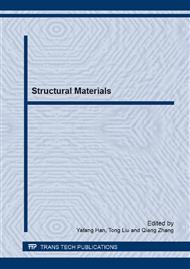[1]
X.L. Shi, S.W. Wang, X.Y. Yang, Q.X. Zhang, Y.F. Wang, Effects of activated sintering process on properties and microstructure of W-15Cu alloy, J. Wuhan Univ. Technol. 25 (2010) 909-913.
DOI: 10.1007/s11595-010-0118-8
Google Scholar
[2]
J.B. Wang, W.G. Chen, B.J. Ding, Electrical breakdown characteristic of nanostructured W-Cu contacts materials, J. Wuhan Univ. Technol. 21 (2006) 32-35.
DOI: 10.1007/bf02841199
Google Scholar
[3]
J.X. Gao, X.F. Xu, K.X. Song, P.Q. Li, X.H. Guo, R.H. Liu, High temperature flow stress prediction of nano-Al2O3/Cu composite using an artificial neural network, Chinese J. Aeronaut. 19 (2006) 36-40.
Google Scholar
[4]
X.B. Liu, C.C. Jia, X.H. Chen, G.S. Gai, Microstructures and properties of 1.0%Al2O3/Cu composite treated by rolling, Trans. Nonferrous Met. Soc. China 17 (2007) 626-629.
Google Scholar
[5]
J.P. Shu, X.L. Shi, S.W. Wang, X.Y. Yang, Q.X. Zhang, Y.F. Wang, Microwave sintering of W-15Cu ultrafine composite powder prepared by spray drying & calcining-continuous reduction technology, J. Wuhan Univ. Technol. 26 (2011) 281-284.
DOI: 10.1007/s11595-011-0213-5
Google Scholar
[6]
W.G. Chen, Z.Y. Kang, B.J. Ding, Preparation and arc breakdown behavior of nanocrystalline W-Cu electrical contact materials, J. Mater. Sci. Technol. 21 (2005) 875-878.
Google Scholar
[7]
B.H. Li, Z.Y. Kang, W.G. Chen, B.J. Ding, Preparation of nanosized W/Cu composite powder by sol-gel technique, Rare Met. 24 (2005) 170-173.
Google Scholar
[8]
J.Q. Tao, X.L. Shi, Properties, phases and microstructure of microwave sintered W-20Cu composites from spray pyrolysis-continuous reduction processed powders, J. Wuhan Univ. Technol. 27 (2012) 38-44.
DOI: 10.1007/s11595-012-0403-9
Google Scholar
[9]
Z.Z. Guo, Y. Sun, L.K. Duan, S.M. Guo, Y.G. Li, Structure and mechanical properties of Cu-W alloy thin films deposited by sputtering, Rare Met. 34 (2010) 38-43.
Google Scholar
[10]
Y.H. Zhang, H.X. Tian, G.S. Zhu, J. Qin, The density and hardness of W-Cu composite materials affected by nanotubes, Nonferrous Met. Sci. Eng. 3 (2012) 33-35.
Google Scholar
[11]
D.D. Gu, Y.F. Shen, Microstructures of laser sintered micron/nano-sized Cu-W powder, Acta Metall. Sin. 45 (2009) 113-118.
Google Scholar
[12]
Y.J. Wang, H.Q. Han, C.L. Xiao, Effects of granularity and component of tungsten powder on the arc erosion resistance of Cu-W contact, Electron. Eng. Mater. 1 (2012) 48-50.
Google Scholar
[13]
S. Zhu, J.L. Fan, T. Liu, J.M. Tian, Electric conductivities of ultrafine W-Cu materials, Trans. Nonferrous Met. Soc. China 20 (2010) 1360-1364.
Google Scholar
[14]
Z.Z. Guo, Y. Sun, C. Zhou, Y.H. Duan, M.J. Peng, Influence of W content on structure and properties of Cu-W alloy thin films Deposited by magnetron sputtering, Mater. Mech. Eng. 35 (2011) 20-24.
Google Scholar


